#ribbed newt
Explore tagged Tumblr posts
Text


Algerian Ribbed Newt (Pleurodeles nebulosus), family Salamandridae, Tunisia
photographs by David Broek
617 notes
·
View notes
Text
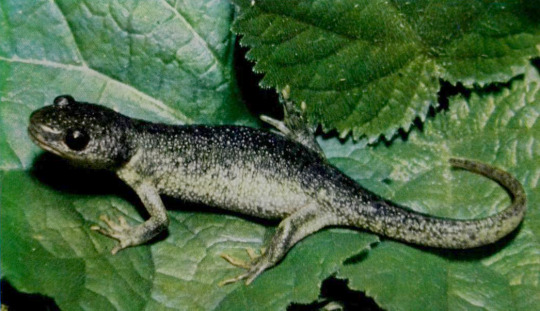
Edough ribbed newt (Pleurodeles poireti) By: Robert S. Simmons From: Living Amphibians of the World 1966
#ribbed newt#salamander#amphibian#1966#1960s#Robert S. Simmons#Living Amphibians of the World (1966)
92 notes
·
View notes
Text
Tbh if people were feeling awkward with the Newt & Anathema sex scene idk how they got through the Job minisode
Like that ox scene was so insanely sexually charged? Felt I should be averting my eyes to give them some urgently needed privacy. Frantically glancing round the room to see if everyone else was getting this
#in contrast i'd actually forgotten about newt & anathema#good omens#aziraphale#crowley#ox ribs#bildad the shuhite#job minisode#good omens 2
141 notes
·
View notes
Text


June Tiny Reptile and Mini Amphibian pin previews: Speckled Tortoise and Iberian Ribbed Newt!
These designs are available on my Patreon until the end of the month and will ship in June!
#newt#iberian ribbed newt#tortoise#speckled tortoise#herpetology#reptile#amphibian#patreon pin club#enamel pins
67 notes
·
View notes
Text
as many of you may have observed, clodsire, when threatened, will protrude large bony spikes from their back to defend themselves. these spikes are, in fact, highly modified rib bones that protrude through tubercles (the white spots on a clodsire’s back). the method of protrusion does in fact involve breaking the skin and forcing the bone through to the outside.
when a clodsire feels provoked, it will not immediately elect for this option. the level of stress and pressure a clodsire must feel to perform the rib-exposing behavior varies from individual to individual, but is consistent within an individual’s behavior (that is, the same clodsire will perform the behavior after the same level of provocation more-or-less every time). clodsire will usually initially defend themselves with their sticky white secretions first and foremost and may wail or bite in self-defense as well.
however, if pushed to the point of exposing their ribs, a clodsire will then use its powerful back muscles and the joints attaching the ribs to the vertebrae to force the bone through the tubercles and out of the body. following this, the clodsire will then secrete its own antimicrobial to prevent infection and accelerate healing.
it is unknown why this behavior evolved. unlike some of the adaptations taken on by the larval stage (commonly called wooper), evidence suggests that this ability existed prior to the habitat fragmentation that, over the last few centuries, has forced clodsire to maintain a more terrestrial lifestyle than quagsire. young paldean wooper, the most vulnerable stage of a clodsire’s life cycle, do not demonstrate this ability until shortly before or after metamorphosis, instead defending themselves primarily by expelling concentrated toxins from glands near their gills. while small subadult clodsire may experience some threats of predation, adult clodsire have few if any predators, particularly if they reach the species’ maximum size of nearly six feet long (which is rarer without an ideal habitat available but still possible).
#pokémon#pkmn irl#clodsire#wooper#[this is based on the second salamander clodsire is based on- the iberian ribbed newt.]#[this is mostly true of the ribbed newt but their ribs actually come out their sides.]#[i also couldn’t find any information on whether ribbed newt larvae can do this so i took my best guess.]#[i also took my best guess at when i think wooper and clodsire became more terrestrial.]#[historically some adaptations have taken place over the timeframe of a few centuries.]#[a famous case being a european moth that changed coloration in response to pollution.]
37 notes
·
View notes
Text
proportioned creature
magestic

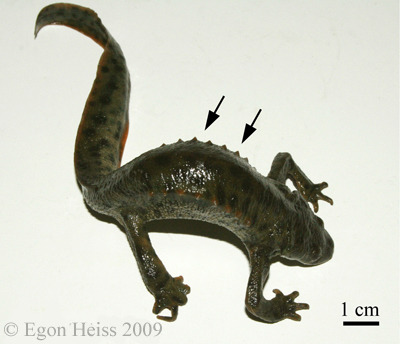

iberian ribbed newt
25 notes
·
View notes
Text
why is newt so lana del rey coded
#is it just me?#whenever i listen to her i just think about newt#dark paradise? summertime sadness? national anthem??#newt my beloved#the maze runner#tmr#newt maze runner#lana del rey#random stuff from my brain#OH lorde too#ribs for newtmas <3#also trouble by cage the elephant while he has the flare but that's a whole other story
12 notes
·
View notes
Text
now kiss >:)
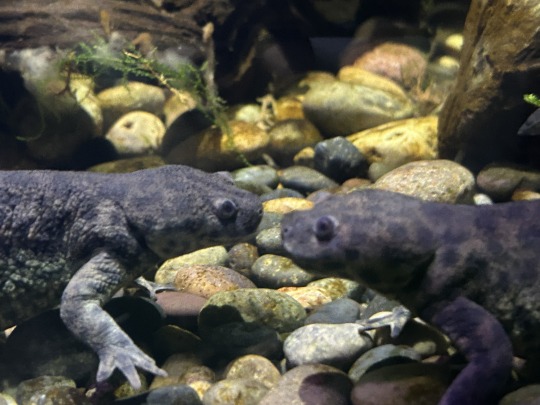
Iberian ribbed newts (Pleurodeles waltl)
2 notes
·
View notes
Text
hA TURNS OUT ITS REAL I WASNT IMAGINING IT. THERE IS A LIZARD/AMPHIBIAN THAT EJECTS ITS RIBS AS DEFENSE

i was talking to my wife [@fweens-clone I FOUND IT] abt impostor anatomy and i mentionedthat i rembered a lizard that could push its ribs out to make spikes. she had no idea what i was talking about nd i honestly thought it didn't actually exist BUT IT DOES!!!!
#raccoon's thoughts#ueah im just glad im not imagining it lol#IBERIAN RIBBED NEWT#and theyre poisonous too????? didnt know that tbh#raccoon's uhaul box#at the time of posting: this was. a while ago. amd i forgot this was in my drafts lol#shhhhhhhhh its not late ignore itttt
4 notes
·
View notes
Text
bursts until tears bc my cat loves me
#newt ooc#she is laying on my ribs rn#and my leg is going a little numb in this position but i think i need to be compressed by my 17lb cat#while chase's looping ambient noise video plays#it won't fix me but it is distracting enough that I'm not thinking about [REDACTED FOR PERSONAL SANITY]
6 notes
·
View notes
Note
ALSO does domestication newt have any physical differences? glowing eyes, scars, ect?
Yep! He's got some funky Kaiju stuff going on from an attempt at altering his body to better suit a terraformed Earth, most noticeably glowing blue eyes with slit pupils, sharp teeth, claws, and blue blood. He also has scaly patches of skin on his back, chest, upper arms, and hips. Plus his tattoos glow sometimes, usually when he's excited or stressed. There's also some less fun things, like how he's technically still warm-blooded, but way more temperature sensitive, so that's part of the reason why he's constantly craving warmth. He can see in the dark, but his eyes are really sensitive. Also those scales can get really itchy.
#precursor newt domestication arc#my weird little man#i love funky part-kaiju newt#i'm thinking about maybe giving him gills on his ribs or the ability to see shrimp colors#i think for this au most of his kaiju stuff is internal#mostly affecting his brain and other organs#so yes he can hold his breath really long or eat almost anything#but his body is still very very messed up and he has a lot of health problems
3 notes
·
View notes
Text
😍😍😍😍😍
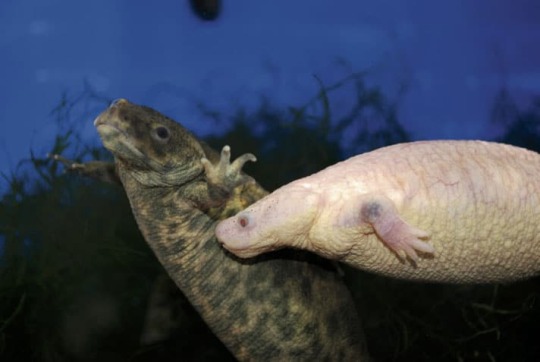
ohhhhhh theyre so epic
11K notes
·
View notes
Text
putting costo iliac impingement syndrome in a post so i don't forget the term
#on the side with the lower rib tip that feels slightly out of place#i can feel them grind together when i tilt my upper torso left while sitting upright#newt needs a text post tag#newt's medical posting
0 notes
Text
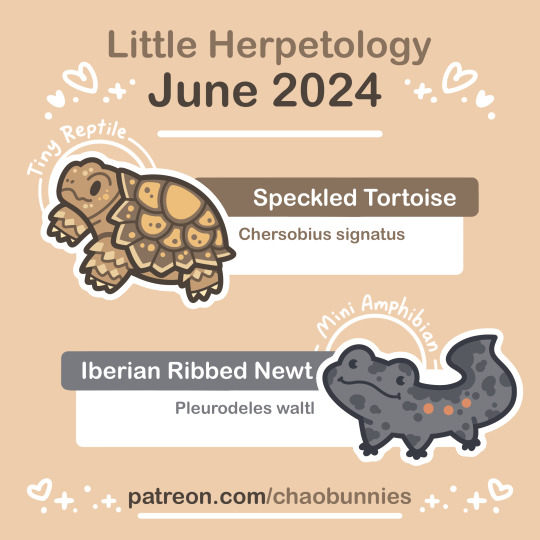
June Tiny Reptile and Mini Amphibians: Speckled Tortoise and Iberian Ribbed Newt! 🐢
Fun facts! The speckled tortoise is the world's smallest tortoise, and the Iberian ribbed newt can defend itself with poisoned ribs!
These designs are available on my Patreon as pins and stickers until the end of the month!
#iberian ribbed newt#speckled tortoise#tortoise#reptile#amphibian#patreon pin club#enamel pins#enamel pin#sticker#stickers#herpetology
49 notes
·
View notes
Text
Iberian or Spanish sharp-ribbed newt
Pleurodeles waltl, the common or Iberian sharp-ribbed salamander, is often sold as a newt. However it belongs to a different subgroup of the salamandrid salamanders, the pleurodelins, of which it is the namesake, and is most closely related to the Asian salamander genera, Echinotriton and Tylotriton. These genera share with Pleurodeles, the defensive habit of using their own ribs, to puncture certain glands that release venom. Newts as phylogenetically defined, belong to the related subclade Molgini, none of which shares this pleurodelin habit, and none of which become as large as Pleurodeles. Pleurodeles waltl reaches a maximum length, of just over 30 centimeters, or 12 inches.
Genus Pleurodeles is indigenous to the Western Mediterranean, where it is found in stagnant freshwater microhabitats, amid xeric scrubland, dry oak woodland, and cultivated landscapes. These are habitats subject to a seasonal climate with hot summers, and the small, stagnant water bodies preferred by P. waltl, may disappear in the Mediterranean dry season. For this reason, P. waltl is thought to leave the water, only when migrating between homes. Such environments might well be man-made irrigation ditches, as easily as natural ponds. These salamanders merely seek still freshwaters, usually of a highly vegetated nature.
The other primary habitat requirement for Pleurodeles, appears to be the turbidity of the pond water. Regarding other variables, such as pH, this genus has a broad tolerance, being found where the pH is as low as 6 and as high as 9. The temperture may, temporarily, get as high as 30 degrees centigrade in the summer months, and as cool as freezing in the winter. Pleurodeles consume primarily aquatic arthropods, gastropods, and annelids, and when they are available, prey on tadpoles and other small vertebrates.
In the aquarium, Pleurodeles can be given a winter temperture of 8 or 9 degrees centigrade, though it is not necessary. During the rest of the year, or year round, these salamanders can be safely maintained at 20 to 23 degrees centigrade. Perhaps according to the locality where they or their ancestors were collected, some Pleurodeles experience heat stress when kept at tempertures, above 23 degrees. Though, it has also been noted, others do not, probably as a matter of source population. These are carnivores that are easy to feed on singing pellets or defrosted and raw foods, of appropriate nature. In the aquarium, they are fine with cohabitants, that are far too large for the newts to try and swallow.
0 notes
Text
You will never be as hardcore as “sticking the sharpened ends of your ribs out of your stomach to stab someone with”.

Red-tailed Knobby Newt aka Kweichow Crocodile Newt (Tylototriton kweichowensis), family Salamandridae, endemic to NE Yunnan, China
Poisonous.
Some species within this genus are capable of poking the tips of their ribs through the orange bumps on the back, which secrete poison. The ribs can effectively become venomous spines that can puncture the potential predator's skin!
photograph by ZTH Photography
#also if you're wondering#the iberian ribbed newt does the same thing#and that was the inspiration for Clodsire
794 notes
·
View notes